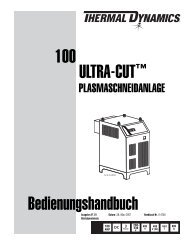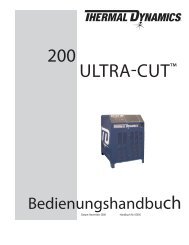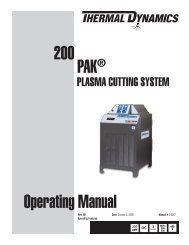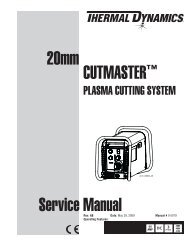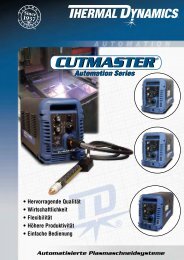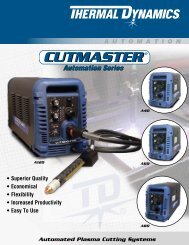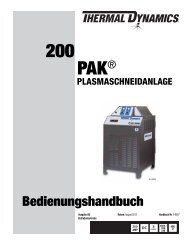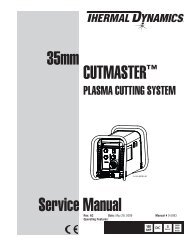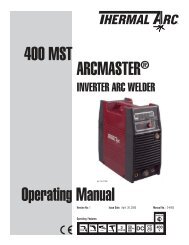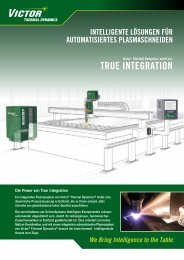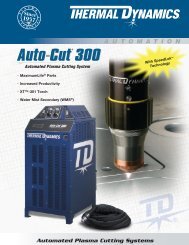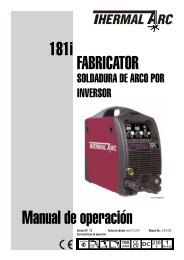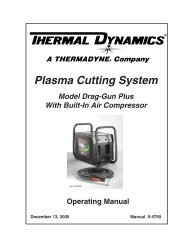211i Operating Manual FabricatOr® - Victor Technologies - Europe
211i Operating Manual FabricatOr® - Victor Technologies - Europe
211i Operating Manual FabricatOr® - Victor Technologies - Europe
You also want an ePaper? Increase the reach of your titles
YUMPU automatically turns print PDFs into web optimized ePapers that Google loves.
SAFETY INSTRUCTIONS FABRICATOR <strong>211i</strong><br />
WARNING<br />
FUMES AND GASES can be hazardous to<br />
your health.<br />
Welding produces fumes and gases.<br />
Breathing these fumes and gases can be<br />
hazardous to your health.<br />
1. Keep your head out of the fumes. Do not breathe<br />
the fumes.<br />
2. If inside, ventilate the area and/or use exhaust at<br />
the arc to remove welding fumes and gases.<br />
3. If ventilation is poor, use an approved air-supplied<br />
respirator.<br />
4. Read the Material Safety Data Sheets (MSDSs)<br />
and the manufacturer’s instruction for metals,<br />
consumables, coatings, and cleaners.<br />
5. Work in a confined space only if it is well ventilated,<br />
or while wearing an air-supplied respirator.<br />
Shielding gases used for welding can displace air<br />
causing injury or death. Be sure the breathing air<br />
is safe.<br />
6. Do not weld in locations near degreasing, cleaning,<br />
or spraying operations. The heat and rays of the<br />
arc can react with vapours to form highly toxic<br />
and irritating gases.<br />
7. Do not weld on coated metals, such as galvanized,<br />
lead, or cadmium plated steel, unless the coating<br />
is removed from the weld area, the area is well<br />
ventilated, and if necessary, while wearing an airsupplied<br />
respirator. The coatings and any metals<br />
containing these elements can give off toxic fumes<br />
if welded.<br />
WARNING<br />
WELDING can cause fire or explosion.<br />
Sparks and spatter fly off from the<br />
welding arc. The flying sparks and hot<br />
metal, weld spatter, hot workpiece, and<br />
hot equipment can cause fires and burns.<br />
Accidental contact of electrode or welding<br />
wire to metal objects can cause sparks,<br />
overheating, or fire.<br />
1. Protect yourself and others from flying sparks and<br />
hot metal.<br />
2. Do not weld where flying sparks can strike<br />
flammable material.<br />
3. Remove all flammables within 35 ft (10.7 m) of the<br />
welding arc. If this is not possible, tightly cover<br />
them with approved covers.<br />
4. Be alert that welding sparks and hot materials from<br />
welding can easily go through small cracks and<br />
openings to adjacent areas.<br />
5. Watch for fire, and keep a fire extinguisher nearby.<br />
6. Be aware that welding on a ceiling, floor, bulkhead,<br />
or partition can cause fire on the hidden side.<br />
7. Do not weld on closed containers such as tanks<br />
or drums.<br />
8. Connect work cable to the work as close to the<br />
welding area as practical to prevent welding<br />
current from travelling long, possibly unknown<br />
paths and causing electric shock and fire hazards.<br />
9. Do not use welder to thaw frozen pipes.<br />
10. Remove stick electrode from holder or cut off<br />
welding wire at contact tip when not in use.<br />
WARNING<br />
FLYING SPARKS AND HOT METAL can<br />
cause injury.<br />
Chipping and grinding cause flying metal.<br />
As welds cool, they can throw off slag.<br />
1. Wear approved face shield or safety goggles. Side<br />
shields recommended.<br />
2. Wear proper body protection to protect skin.<br />
WARNING<br />
CYLINDERS can explode if damaged.<br />
Shielding gas cylinders contain gas under<br />
high pressure. If damaged, a cylinder can<br />
explode. Since gas cylinders are normally<br />
part of the welding process, be sure to<br />
treat them carefully.<br />
1. Protect compressed gas cylinders from excessive<br />
heat, mechanical shocks, and arcs.<br />
2. Install and secure cylinders in an upright position<br />
by chaining them to a stationary support or<br />
equipment cylinder rack to prevent falling or<br />
tipping.<br />
3. Keep cylinders away from any welding or other<br />
electrical circuits.<br />
4. Never allow a welding electrode to touch any<br />
cylinder.<br />
<strong>Manual</strong> 0-5225 1-3 SAFETY INSTRUCTIONS AND WARNINGS



